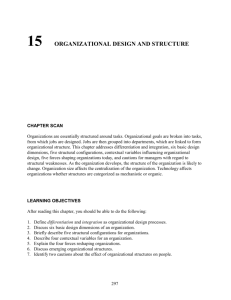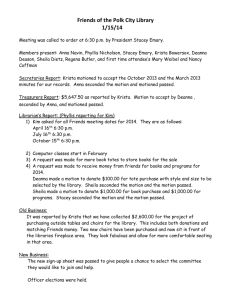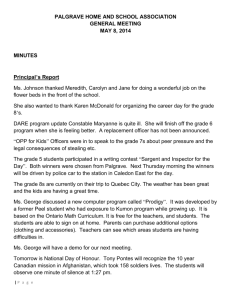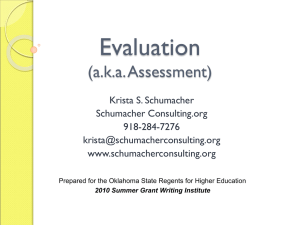15 ORGANIZATIONAL DESIGN AND STRUCTURE
advertisement
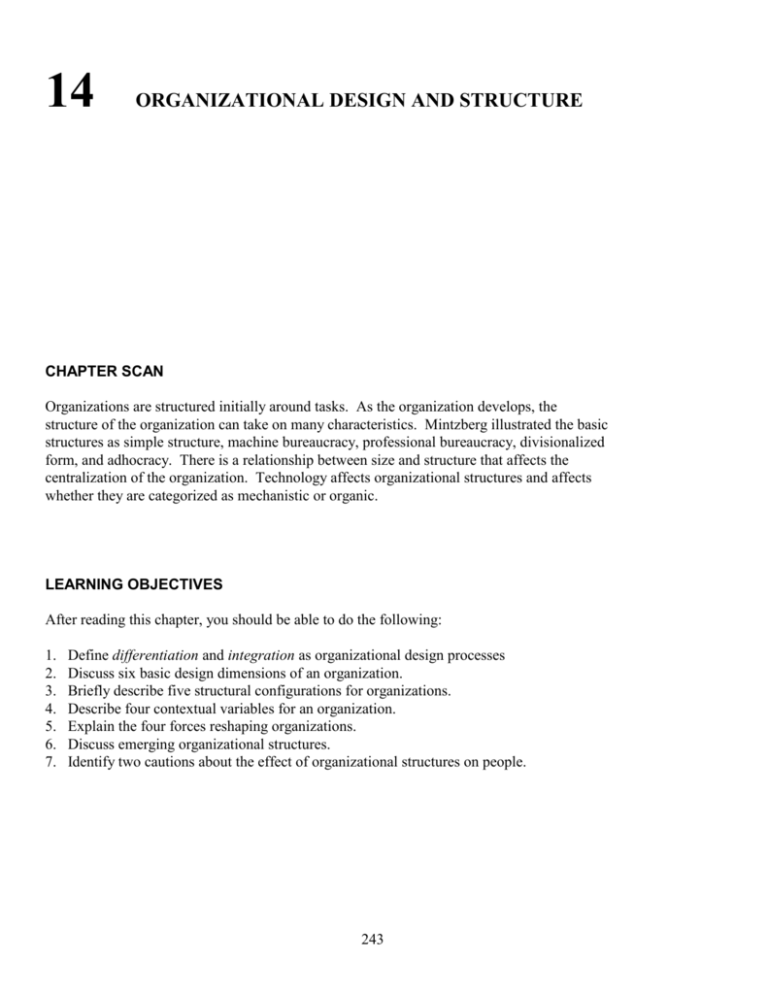
14 ORGANIZATIONAL DESIGN AND STRUCTURE CHAPTER SCAN Organizations are structured initially around tasks. As the organization develops, the structure of the organization can take on many characteristics. Mintzberg illustrated the basic structures as simple structure, machine bureaucracy, professional bureaucracy, divisionalized form, and adhocracy. There is a relationship between size and structure that affects the centralization of the organization. Technology affects organizational structures and affects whether they are categorized as mechanistic or organic. LEARNING OBJECTIVES After reading this chapter, you should be able to do the following: 1. 2. 3. 4. 5. 6. 7. Define differentiation and integration as organizational design processes Discuss six basic design dimensions of an organization. Briefly describe five structural configurations for organizations. Describe four contextual variables for an organization. Explain the four forces reshaping organizations. Discuss emerging organizational structures. Identify two cautions about the effect of organizational structures on people. 243 244 Chapter 14: Organizational Design and Structure KEY TERMS The following key terms are introduced in Chapter 14. organizational design organizational structure contextual variable differentiation integration formalization centralization specialization standardization complexity hierarchy of authority simple structure machine bureaucracy professional bureaucracy divisionalized form adhocracy technological interdependence environment task environment environmental uncertainty organizational life cycle THE CHAPTER SUMMARIZED I. THINKING AHEAD: Organizing for Emergencies, Crises, and Disaster Relief Organizational design is the process of constructing and adjusting an organization's structure to achieve its goals. Organizational structure is the linking of departments and jobs within an organization. The contextual variables that influence organizational design are size, technology, environment, and strategy and goals. II. KEY ORGANIZATIONAL DESIGN PROCESSES Chapter 14: Organizational Design and Structure A. Differentiation Differentiation is the process of deciding how to divide the work in an organization. Differentiation is a check to ensure that all aspects of the tasks are assigned and will be accomplished. One of the earlier studies found four dimensions (1) manager's goal orientation, (2) time orientation, (3) interpersonal orientation, and (4) formality of structure. B. Integration Integration is the process of coordinating the different parts of an organization. III. BASIC DESIGN DIMENSIONS The basic design dimensions are broad, and include the following: Formalization is the degree to which the organization has official rules, regulations, and procedures. An organization may have a formal structure, but may operate informally. Centralization is the degree to which decisions are made at the top of the organization. The quality movement and programs that stress delegating responsibility and decision making to lower levels result in decentralization. At the same time, reductions in organizations have altered the middle management tier of the organization by eliminating part of the central reporting structure. Typically, the larger and longer the organization has been in existence, the more centralized will be its structure. Specialization is the degree to which jobs are narrowly defined and depend on unique expertise. Standardization is the extent to which work activities are described and performed routinely in the same way. Complexity refers to the number of different types of activities that occur in the organization. The hierarchy of authority is the degree of vertical differentiation across levels of management. Organizations that are highly specialized, formalized, and centralized, typically have a tall hierarchy of authority, and are highly bureaucratic. The term bureaucracy has not always had the negative connotation that it carries today. Max Weber coined the expression to mean a complex organization, based on hierarchy of authority and adherence to rules. IV. FIVE STRUCTURAL CONFIGURATIONS Mintzberg provides five structural configurations for organizations. A. Simple Structure The simple structure is a centralized form of organization that emphasizes the upper echelon and direct supervision. Most organizations pass through the simple structure in their formative years. It is the riskiest structure because success is often based on whims. 245 246 Chapter 14: Organizational Design and Structure B. Machine Bureaucracy The machine bureaucracy is a moderately decentralized form of organization that emphasizes the technical staff and standardization of work processes. C. Professional Bureaucracy The professional bureaucracy is a decentralized form of organization that emphasizes the operating level and standardization of skills. One of the difficulties that hospitals face is the professional bureaucracy. Physicians typically are loyal to their profession rather than to the hospitals in which they practice. D. Divisionalized Form The divisionalized form is a moderately decentralized form of organization that emphasizes the middle level and standardization of outputs. E. Adhocracy The adhocracy is a selectively decentralized form of organization that emphasizes the support staff and mutual adjustment among people. V. CONTEXTUAL VARIABLES A. Size The larger the organization, the more likely the basic design dimension will be formalized, central, specialized, standardized, and complex. Additionally, the hierarchy of authority is typically a tall structure. Large organizations also reap the efficiency advantages of economies of scale. B. Technology Joan Woodward classified technologies by their complexity. Others considered the rate of change of the technology to determine the best organizational structure. Technological interdependence is the degree of interrelatedness of the organization’s various technological elements. Chapter 14: Organizational Design and Structure C. 247 Environment The organizational environment is considered anything outside the boundaries of an organization. The task environment includes elements that are specifically related to the attainment of the organization's goals. Burns and Stalker compared the rate of change and determined that organizations with stable technologies typically have an organic or flexible structure. Those with low rates of change were mechanistic structures. The perception of environmental uncertainty or the perception of the lack of environmental uncertainty is how the contextual variable of environment most influences organizational design. D. Strategy and Goals Table 14.6 compares formalization, centralization and complexity in relationship to strategic decision processes. There is commonality across the characteristics of all three processes. VI. FORCES RESHAPING ORGANIZATIONS A. Life Cycles in Organizations The organizational life cycle is comprised of differing stages of an organization's development from birth to death. The initial stages of the life cycle exhibit aspects of organic structures. As organizations progress through the stages they become more mechanistic. B. Globalization As organizations develop globally, they often change their structures to accommodate the decentralization necessary because of geographic boundaries. As companies become transnational in perspective they are likely to have two or more headquarters. C. Changes in Information-Processing Technologies Technology serves to share resources and can enhance either a structure of centralization or decentralization. D. Demands on Organizational Processes Organizations must adapt quickly to changes at a pace unprecedented in organizational history. 248 Chapter 14: Organizational Design and Structure E. Emerging Organizational Structures Emerging structures will necessarily consider the dynamics and issues surrounding total quality management. VII. CAUTIONARY NOTES ABOUT STRUCTURE Not all structures are advantageous, particularly if they are deficient in some area. If the hierarchy is overloaded with too much information, decision making is cumbersome and delayed. At the highest levels, the personality of the chief executive may affect the organization's structure. VIII. MANAGERIAL IMPLICATIONS: FITTING PEOPLE AND STRUCTURES TOGETHER IX. LOOKING BACK: American Red Cross Disaster Response Field Organizations CHAPTER SUMMARY Three basic types of differentiation occur in organizations: horizontal, vertical, and spatial. The greater the complexity of an organization because of its degree of differentiation, the greater the need for integration. Formalization, centralization, specialization, standardization, complexity, and hierarchy of authority are the six basic design dimensions in an organization. Simple structure, machine bureaucracy, professional bureaucracy, divisionalized form, and adhocracy are five structural configurations of an organization. The contextual variables important to organizational design are size, technology, environment, and strategy and goals. Life cycles, globalization, changes in information-processing technologies, and demands on process capabilities are forces reshaping organizations today. New, emerging organizational structures differ from the traditional ones. Organizational structures may be inherently weak or chief executives may create personality-organization constellations that adversely affect employees. Chapter 14: Organizational Design and Structure REVIEW QUESTIONS: SUGGESTED ANSWERS 1. Define the processes of differentiation and integration. Differentiation is the process of deciding how to divide the work in an organization. Integration coordinates the different parts of an organization. 2. Describe the six basic dimensions of organizational design. Formalization is the degree to which the organization has official rules, regulations, and procedures. Centralization is the degree to which decisions are made at the top of the organization. An organization is specialized if the jobs are narrowly defined and require specific, unique expertise. If the tasks are fairly routine, the organization structure would be standardized. If the organization has multiple types of activities occurring, the dimension would be complex. Hierarchy of authority is the degree of vertical differentiation across levels of management. 3. Discuss five structural configurations from the chapter. The five configurations are from Mintzberg's research. A simple structure is centralized, having direct supervision and the upper management has the dominant impact. Most small organizations adopt this structure, or early organizations before the growth phase. The machine bureaucracy has a specialized technical staff with limited decentralization. Professional bureaucracy organizations are highly skilled, and have vertical and horizontal decentralization in the organization. Divisionalized forms key on the middle level, and are standardized in their outputs. Adhocracy supports staff, and practices a form of selective decentralization. 4. Discuss the effects of the four contextual variables on the basic design dimensions. The four variables are size, technology, environment, and strategy and goals. As these elements change, so will the design of the organization. In general, large organizations are more formalized, specialized, standardized, and complex than smaller ones. They also have taller hierarchies and low centralization. Determining the relationship between technologies and basic dimensions is more complicated. One pertinent stream of research is Thompson's, who suggested that greater technological interdependence produces greater complexity and the need for more decentralized decision making. One way of looking at the environment is to use Burn's and Stalker's perspective. If the environment is complex, an organic structure is better. The relationship between strategy and goals and the basic design dimensions is summarized in Table 14.5. 249 250 Chapter 14: Organizational Design and Structure 5. Identify four forces that are reshaping organizations today. Downsizing affects the hierarchical structure, team and group orientations alter job designs, globalization changes the centralization concept, and technology is intended to reduce duplication. 6. Discuss the nature of emerging organizational structures. One of the key ideas in total quality management is organizing around processes. New structures will be characterized by this type of organizing, along with an emphasis on selfmanaged teams. Organizations are also becoming more horizontal as they downsize, eliminating layers of management. The modular corporation is another emerging design, with its emphasis on outsourcing rather than vertical integration. 7. List four symptoms of structural weakness and five unhealthy personality-organization combinations. Symptoms of structural weakness include: (1) delayed decision making because the hierarchy is overloaded; (2) poor quality decisions because information linkages are not effective; (3) lack of innovative responses to the changing environments because of poor coordination; and (4) conflict among departments because of a lack of shared strategies and goals. Five dysfunctional combinations of executive personality and organization are: paranoid, depressive, dramatic, compulsive, and schizoid. DISCUSSION AND COMMUNICATION QUESTIONS: SUGGESTED ANSWERS 1. How would you describe the organization you work for (or your college) on each of the basic design dimensions? For example, is it a very formal organization or an informal organization? Most students will see their organization as formal, particularly university structures. 2. Do the size, technology, and mission of your organization directly affect you? How? Students typically relate to the size and technology aspects of this question, rather than the strategy and goals, which are harder to ascertain. 3. Who are your organization's competitors? What changes do you see in informaiton technology where you work? Chapter 14: Organizational Design and Structure 251 Students are likely to identify competitors in the local market, and may need to be reminded of global competition. The geographic range of competition will, of course, vary depending on the type of industry. Students will readily identify changes such as increased computerization and the use of email and the internet. Some workplaces, of course, may have more advanced technologies. 4. Does your company show any one or more of the four symptoms of structural deficiency discussed at the end of the chapter? Students should be prompted to think about why these deficiencies occur, and how they can be altered. 5. Write a memo classifying and describing the structural configuration of your university based on the five choices in Table 14.2. Do you need more information than you have to be comfortable with your classification and description? Where could you get the information? Students should give specific examples and characteristics of the university to support their choices. 6. Interview an administrator in your college or university about possible changes in size (Will the college or university get bigger? smaller?) and technology (Is the college or university making a significant investment in information technology?). What effects does the administration anticipate from these changes? Be prepared to present your results orally to the class. It would be a good idea to coordinate in-class who students are interviewing so that a wide variety of administrators are approached. Class discussion can then focus on similarities and differences in the responses an how each administrator’s frame of reference influences his or her perspective on these issues. ETHICS QUESTIONS: SUGGESTED ANSWERS 1. For what types of individual behavior is it ethical for an organization to have formal rules and regulations? For what types of individual behavior is it unethical for an organization to have formal rules and regulations? Job related policies are the easiest category. However, there is an increase in the policies that relate to employees off the job. For example, some organizations will not provide insurance coverage for smokers. 252 Chapter 14: Organizational Design and Structure 2. Should legal limits be set to prevent large companies from engaging in very competitive behavior to drive small companies out of business? These laws and regulations exist, although students may be opinionated as to the degree in which they should exist. 3. As an organization changes its structure over time, how much commitment should it show to employees who need to be retrained to fit into the new system? Or is it acceptable for the organization to hire new people to fit the new structure? Both of these approaches are acceptable, however, it is illegal to exchange older employees for newer employees as a direct cost saving benefit. 4. Suppose an employee complains about organizational design problems and suggests a solution. The organization is redesigned accordingly, but that employee's department is eliminated. Is it ethical for the company to terminate the employee? Should the company always make room for a person who has a beneficial idea for the organization? This is closely related to the underlying concept of entitlement. Entitlement is the belief that an organization owes a job to employees that are loyal, performing, and committed. Entitlement laws are vastly different from country to country. CHALLENGES 14.1 HOW DECENTRALIZED IS YOUR COMPANY? This might be a good challenge for students to complete prior to the discussion on decentralization. Students can then share their perceptions of their companies as examples during the discussion. EXPERIENTIAL EXERCISES 14.1 WORDS-IN-SENTENCES COMPANY The purpose of this exercise is to understand issues of organizational design. Because the students are given a fairly easy and innocuous assignment, it is not difficult to see how the design issues of the various groups influence the success of the outcome. It is better to have several groups, so if the class is smaller, then assign groups to have only six members. By having several groups, it is possible to compare later which design worked best for this type of task. Chapter 14: Organizational Design and Structure 253 If you can, assign one observer per group so that the debrief will be richer. Using observers to “float” is highly beneficial to learning. They still have their “home” group, but they freely move throughout the various groups. This gives them much more insight and ability to give more meaningful feedback later. You should give each group the raw material words, preferably on a notecard or a piece of paper, so that each group gets a notecard. Some possibilities include: organic and mechanic Lawrence and Lorsch task and design Woodward on technology Using raw materials related to the concepts of this exercise seems to reinforce the learning. During the debrief, spend a lot of time on what the groups learned from Production Run #1 to Production Run #2. If they reorganized, how so and why? Some groups reorganize, but it is senseless. What information did they get from #1 that led them to the changes in #2? Was the outcome better? SOURCE: Dorothy Marcic, Organizational Behavior Experiences and Cases, 4th Ed. (St. Paul: West, 1995), 303-305. 14.2 DESIGN AND BUILD A CASTLE Instructor's Notes This exercise is intended to give students an opportunity to design an organization and produce a product. Students are in groups (of 6-8 members) of one of three productdevelopment teams working within the research and development division of the General Turret and Moat Corporation. Each of the 3 teams designs a castle for the company to produce and sell. Given limited resources, the company cannot put more than one design on the market. Therefore, the company will have to decide which of the three designs it will use and discard the others. Students are given 45 minutes to complete the project. Exercise Schedule 1. (5 minutes) Each group is designated either #1, #2, or #3. Members read only one memorandum, the appropriate one for their group. One (or two for larger groups) observers are selected for each group. Observers read their materials. 2. (10 minutes) Groups design their organization in order to complete the goal. 3. (15-20 minutes) Each group designs its own castle and draws it on newsprint. 4. (5-10 minutes) “Typical consumers” (may be observers or others) tour building locations and hear sales pitches. Judges caucus to determine the winner. 254 Chapter 14: Organizational Design and Structure 5. (10-15 minutes) Groups meet again and write up the central goal statement of the group. Also write the organization chart on newsprint with the goal written beneath. These are posted around the room. 6. (5-15 minutes) Instructor leads a class discussion on how the different memos affected organization design. Which design seemed most effective for this task? Option 2 If there is time, have students actually build the castles. To build the castles, you may give students: a. Sheets of plain/scratch paper and tape, or b. Sheets of colored construction paper, staples and tape, or c. Paper, sheets of cardboard or tagboard, staples and tape, or d. Paper, staples, tape plus handfulls of shredded paper (from a paper shredder) Discussion Questions 1. What do you think made one “castle” “win” over the others? 2. How much difference did the “sales pitch” make? 3. Is one group’s organizing structure better than another’s? Are others more useful in different “Castle Companies” or different situations? 4. Was communication influenced by any particular structure? 5. What other dynamics of your group seemed to be important and influenced your final product? Chapter 14: Organizational Design and Structure 255 CASTLE BUILDING MEMORANDUM TO: PROJECT TEAM #1 FROM: Edward Grimsbsy Bullhouse, III Chief Executive Officer General Turret and Moat Corporation SUBJECT: Development of new castle product In order to perform effectively and to develop a useful product for our firm, I have decided that will serve as manager of product development team #1. It is responsibility to see that the team develops a useful and feasible product, and I hope that all of you will cooperate with in this effort. 256 Chapter 14: Organizational Design and Structure CASTLE BUILDING MEMORANDUM TO: PROJECT TEAM #2 FROM: Edward Grimsbsy Bullhouse, III Chief Executive Officer General Turret and Moat Corporation SUBJECT: Development of new castle product In order to perform effectively and to develop a useful product for our firm, I am asking that you select one of your team to serve as manager of product development team #2. I trust that you will also determine and select any committees, task forces, subgroups, etc. that are needed in order to perform your job. Chapter 14: Organizational Design and Structure 257 CASTLE BUILDING MEMORANDUM TO: PROJECT TEAM #3 FROM: Edward Grimsbsy Bullhouse, III Chief Executive Officer General Turret and Moat Corporation SUBJECT: Development of new castle product In order to perform effectively and to develop a useful product for our firm, I am asking that each of you put forth your maximum effort. I trust that you will provide us with a worthwhile product that can contribute to the profits of the firm. 258 Chapter 14: Organizational Design and Structure CASTLE BUILDING Observer’s Guide During the course of the building period, observe what is happening within your particular group. Specifically, you should look for the following things. 1. What was the reaction of the group to the memorandum? 2. What was the basic structure of the group? 3. To what degree did people specialize and work on the same particular part of the overall task? How did this specialization come about? 4. Who was (were) the leader(s) of the group? How was leadership determined? How effective was the leadership in helping the group to perform its task? 5. Were there any specific patterns of communication among members of the group, or did everyone talk with everyone else? 6. How were important decisions made? Did you see conflicts or were decisions made cooperatively and with compromise? 7. Other general observations After the session, be prepared to discuss your observation with the entire group. Chapter 14: Organizational Design and Structure 259 ALTERNATIVE EXPERIENTIAL EXERCISE: THE GLITCH THAT LOST KRISTA Instructor's Notes: This excerpt is a true story. The episode is followed by legal and human resources experts who briefly suggest how to cope with this colorful character. Many employees are overlooked and treated as if they don't exist. With little attention and feedback, they become bored and complacent. This management problem may have encouraged Krista to "play dumb and stay lost." Any time a company undergoes a reorganization, it should include a personal meeting with every employee to explain or discuss the impact on the employee's job. Despite the fact that the agency did not handle the reorganization appropriately, it has the right to hold Krista responsible for her actions. She should have received discipline for being AWOL. This story demonstrates an often overlooked point. Employees have no obligation to seek out work. Whether private or public, it is management's obligation and legal right to insist that employees perform assigned duties in a satisfactory manner. This seems obvious, but many employers are reluctant to exercise their basic right to tell employees to go back to work when such situations arise. 260 Chapter 14: Organizational Design and Structure THE GLITCH THAT LOST KRISTA Elizabeth N. Fried, Outrageous Acts of Behavior, Intermediaries Press, Dublin Ohio, 1990. Chase was quite pleased. He was instrumental in redesigning the organization and implementing the communication program. He arranged for small-group meetings so that employees could understand the need for reorganization. The process took him nearly a month of continuous meetings, but the response was favorable. The employees cooperated and helped make the transition very smooth. After six weeks, the first productivity report showed a fifteen percent decrease in expenses, and morale seemed stable. The agency had plans to administer a work-climate study after twelve months. Chase was immersed in the glowing productivity report when his assistant, Suzanne, walked in his office. "Here they are, fresh off the presses, our first run since the reorganization," Suzanne chirped. Chase looked up from his desk puzzled, "What?" "The performance review reminders," Suzanne responded. "You know, every month we get a printout for those employees due for their annual performance review. They have little computer-generated postcards that we send out to the managers." "Oh, right, right. Go ahead and send them out," Chase said, still preoccupied with his productivity report. Several days later he got a call from Gordon Fishman, the information officer. "Say, Chase," Gordon began, "I just got the computer reminder to give Krista Reed, one of my former clerks, her performance review. Since we reorganized, Krista doesn't work for me any more." Krista was fairly far down in the organization, so her name would not show up on the major charts. Chase remembered hiring her about three years ago for a simple, routine clerk job. She was rather plain, not very bright, but quite pleasant. When her performance reviews had crossed his desk, there was nothing unusual. They were mostly peppered with satisfactories. She had received only one promotion in three years and tended to blend right into the agency. "Well, what happened to her?" Chase asked. "I'm not really sure, but I think she's reporting to Bill Acton in Administration. Try him," Gordon responded. Chase looked up Bill's extension. "Say, Bill, this is Chase Vidmar. We have a performance appraisal due on Krista Reed, and I understand she report to you now." "Krista Reed: Nope, not me. I think she was shipped over to Tracy Karras after the reorganization. Give Tracy a call," Bill suggested. Chase tapped out Tracy's four-digit extension. "Ms. Karras's office, Jane speaking." "Hi, Jane, this is Chase Vidmar. Is Tracy available?" "Sorry, Mr. Vidmar, but Tracy is out of the office at a meeting with one of our vendors." "Oh, he paused, "well, maybe you can help me. Does Krista Reed report to your section?" Chapter 14: Organizational Design and Structure 261 "That name doesn't sound familiar, but I'll check. Can you hold?" "Sure." Chase waited while he scanned his own personnel computer runs. There was Krista Reed's name all right. She still retained Gordon Fishman's budget code, but the section reassignment code was blank. That's why the performance appraisal reminder defaulted to Gordon. "Where the hell could she be?" he thought. Jane returned to the line. "Sorry, Mr. Vidmar, but we don't have her here." "Thanks, Jane." Chase rang off and sat at his desk bewildered. The agency had over two thousand people and he wasn't about to send out a missing-rewards memo on Krista. She was getting her paycheck. That must be a clue. "Rats," he thought, after he checked with payroll. "My luck, she has her pay directdeposited, with the confirmation mailed to her home. "Her home," he thought, "maybe she's at home. I'll try there." for an entire week Chase periodically called Krista's number - no answer or busy. He was getting very frustrated. Chase usually worked through his lunch, grabbing some junk food from the vending machine. Today he felt especially hungry for some reason, so he ventured into the employee cafeteria. He filled his tray from the deli bar and passed through the register. Seated a few tables from the register was Krista Reed! Chase couldn't believe his eyes. His surprise almost caused him to set his Coke off balance. He regained control and casually sauntered over to Krista, who was seated with some other women. There was an available seat across from her. "Mind if I join you?" Chase asked politely. "Sure, no problem," Krista smiled. "So, Krista, it's been a long time since we've talked. How have you been?" "Pretty good." "So where are you working now that we've reorganized?" he asked. "I'm glad you asked," she responded sincerely. "When everyone got their printout of where to be reassigned, the section for me was blank. My boss was tied up in meetings that day, so I didn't get to discuss it with him. Even though the move wasn't scheduled for two weeks, I wasn't able to get to him because I left that Friday for my two-week vacation. So, when I returned, everyone was in their new offices, and my boss, as you know, was shipped over to Building G across the complex. My section was split three ways, so I didn't even know which group to follow and haven't known what to do. I've felt really lost and kind of upset that the agency has forgotten about me. So I just came to work and visited with friends in the various break rooms, and then I'd sit through all three lunch sessions. That part has been a lot of fun, but to tell the truth, I've been getting kinda bored." "That's terrible, Krista," Chase feigned sympathetically. "And not only that," she added "with all these lunches I've eaten over the past several weeks, I've gained nearly eight pounds!" Chase was astounded. He knew Krista wasn't a rocket scientist, but how could she spend over a month occupying her day having one long lunch, just hoping someone might notice? Incredibly, no one did notice, and Krista appeared deadly serious and wholly sincere. Rather than embarrass himself and the whole agency for the major snafu, Chase politely suggested to 262 Chapter 14: Organizational Design and Structure Krista that she return with him to his office. He reviewed the organizational design study and determined where Krista should logically be located. Chase contacted the section manager and notified him that he was sending Krista on up. The he put a change action through to the computer to ensure that the elusive Krista would once again have a home. Discussion Questions: 1. What type of organizational structure is this most likely to have occurred in? 2. What organizational response should have taken place to prevent this situation? 3. Do you believe this could happen in a restructuring company? Chapter 14: Organizational Design and Structure EXTRA EXPERIENTIAL EXERCISES The following alternative exercise to supplement the material in the textbook can be obtained from: Marcic, Dorothy & Seltzer, Joe. Organizational Behavior: Experiences and Cases, 5th Ed. South Western College Publishing Company, 1998. The Four Frame Model: Analyzing a Hospital Department Consolidation. p. 235-239. Time: 50 minutes. Purpose: To introduce and provide an example of the use of Bolman and Deal's fourFrame Model. The Honda Case: Designing for Quality. p. 244-249. Time: 40 minutes. Purpose: To explore a Japanese approach to designing an organization for quality. 263
